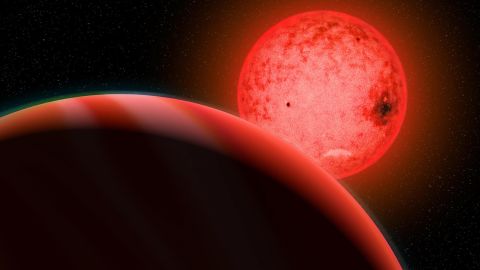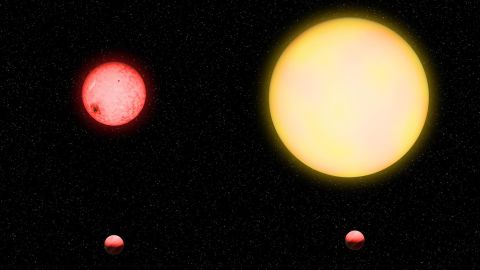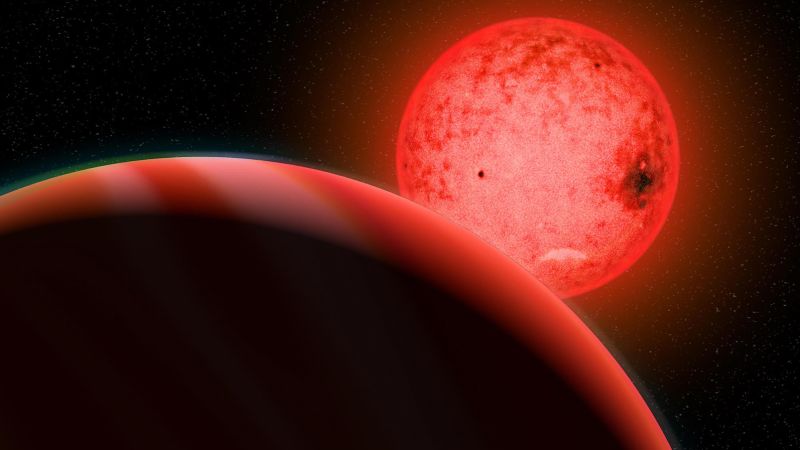Surprising ‘forbidden planet’ discovered outside our solar system

Sign up for CNN’s Wonder Theory science newsletter. Explore the universe with news on fascinating discoveries, scientific advancements and more.
CNN
—
Astronomers have found an unusually large planet orbiting a small star, located about 280 light-years from Earth.
The unexpected size of the newly discovered world, called TOI 5205b, has led researchers to call it the “forbidden planet.”
About the size of Jupiter, it was spotted by researchers using NASA’s Transiting Exoplanet Survey Satellite, or TESS. Jupiter is the largest planet in our solar system.

The planet-hunting mission, launched in 2018, surveys the light of the nearest and brightest stars to spot dips in starlight, which suggests those stars have planets orbiting them. The TESS mission has found thousands of potential planets.
The exoplanet orbits a red dwarf star called TOI-5205, which is about 40% the size and mass of our sun, and about 5,660 degrees Fahrenheit (3,127 degrees Celsius) in temperature compared with the sun’s blazing average of 9,980 F (5,527 C).
An M dwarf star is smaller, cooler and redder than our sun. These dim stars are some of the most common in the universe, and in recent years, astronomers have discovered that M dwarf stars are more likely to have planets orbiting them.
But astronomers weren’t expecting such small stars to host giant planets — and that’s exactly what they found when they took a closer look at the TOI-5205 planetary system.
A study detailing the findings was published Tuesday in The Astronomical Journal.
“The host star, TOI-5205, is just about four times the size of Jupiter, yet it has somehow managed to form a Jupiter-sized planet, which is quite surprising,” said study author Shubham Kanodia, a postdoctoral fellow at the Carnegie Institution for Science in Washington, DC, in a statement.
Astronomers have found a few gas giant planets orbiting older M dwarf stars, but TOI 5205b is the first gas giant to be found around a low-mass M dwarf star.
The researchers compared the planet to a pea going around a lemon. In our solar system, Jupiter could be compared to a pea orbiting a grapefruit (standing in for our sun).

When TOI 5205b crosses in front of its star during orbit, the planet blocks 7% of its light.
The discovery of the planetary system challenges theories on planet formation.
Stars form from massive clouds of gas and dust in space. The leftover material from star formation swirls around the star and creates a rotating disk where planets are born.
“TOI-5205b’s existence stretches what we know about the disks in which these planets are born,” Kanodia said.
“In the beginning, if there isn’t enough rocky material in the disk to form the initial core, then one cannot form a gas giant planet. And at the end, if the disk evaporates away before the massive core is formed, then one cannot form a gas giant planet. And yet TOI-5205b formed despite these guardrails. Based on our nominal current understanding of planet formation, TOI-5205b should not exist; it is a ‘forbidden’ planet.”
Researchers want to observe the planet in the future using the James Webb Space Telescope, which could detect if TOI-5205b has an atmosphere and unlock more of the secrets about how it formed.
Data collected from the Habitable Zone Planet Finder on the 10-meter Hobby-Eberly Telescope at the University of Texas at Austin’s McDonald Observatory is showing the potential for future discoveries, according to the research team.
Observations “are already hinting at the presence of more such planets, which suggests that TOI-5205 b — while definitely an outlier — isn’t the only one,” Kanodia wrote in a blog post.







